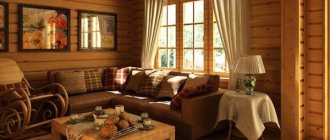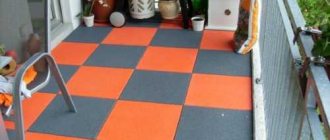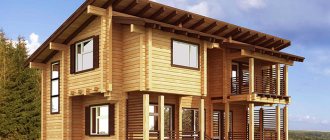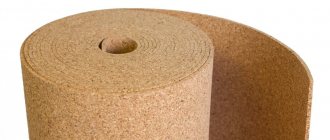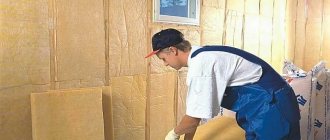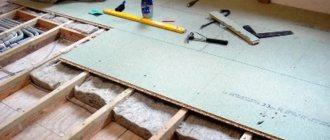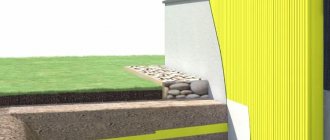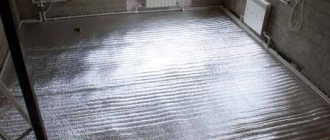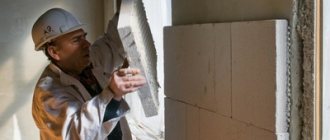Many private houses are often built on columnar or pile foundations. Naturally, with such a basis, the floor of the first floor turns out to be “floating” in the air, that is, not having direct contact with the ground. By the way, quite often the same technique is used when building on a strip foundation. But the fact that the floor is separated from the ground by an air gap does not mean that its insulation is unnecessary. The underground space must be ventilated, that is, the temperature there will be comparable to the air temperature outside. And in order for comfortable living conditions to be maintained in the room, and the floor structure itself to be durable, thermal insulation is mandatory, for example, insulating the foundation with foam plastic.
Insulation of a wooden floor - calculating the thickness
The spaces between load-bearing floor beams and/or joists are a very convenient place to place thermal insulation material. But even at the construction planning stage, a logical question should arise - what should be the thickness of the insulating layer? After all, this can directly affect the cross-section of lumber from which the load-bearing parts of the floor structure will be made.
The issue is important, so it was decided to include it in a separate publication. So, let's look at the problem: insulating a wooden floor - we calculate the thickness of the thermal insulation.
Insulation of wooden floors along logs
Before starting work, you should carry out small calculations and pay attention to such parameters as: the purpose of the floor and the load on it, humidity and temperature in the room, the presence or absence of an insulated blind area around the house. All this will ultimately simplify the further selection of material for insulation, and will also allow you to calculate the required thickness of the insulation layer. The technology for floor insulation using joists is quite simple, unlike the same concrete work, which allows a person who has never done this before to handle it with their own hands.
The floor insulation cake, in the most general case, has the following form:
- Subfloor - serves as the basis for laying insulation;
- Waterproofing layer – prevents the insulation from getting wet from atmospheric moisture;
- Thermal insulation - selected depending on the financial capabilities and characteristics of the room;
- Vapor barrier layer - prevents contact of the insulation with moisture coming from the room;
- Clean floor covering.
Insulation along joists is the most common, as it is simple, effective and able to avoid significant heat loss, which is especially necessary for floors located close to the ground.
General information
The thickness of the material is selected depending on the climate of the region. One indicator is provided for the northern republics, and another for the southern republics.
Firstly, the thicker the insulation, the better the heat is retained, and the less energy is spent on heating. Secondly, insulation also saves you from heat. Thirdly, insulation is a good sound insulator.
The thickness varies depending on the type of floor and its location. The floor of the first floor is the coldest, especially if the house is on stilts and is ventilated from below. But it can be earthen if the foundation is strip, and concrete if it is slab.
The floors between floors are heated on both sides. Insulation is used only as sound insulation.
The attic floor is also a floor. It must be insulated, especially if the attic is unheated. Otherwise, the heat will go outside, and in addition condensation will appear on the ceiling.
Insulation thickness under a heated floor system
Each material has its own thermal conductivity coefficient. This parameter is of primary importance when determining the thickness of insulation.
Thermal conductivity of insulation of different densities
The effectiveness of insulation also depends on the density. The higher it is, the more difficult it is for the insulator to retain heat.
Comparison of thermal conductivity of materials
12 cm of polystyrene (density, however, not indicated) will retain heat as effectively as 210 cm of solid red brick.
Floor insulation scheme
So, let's consider a floor insulation scheme in a house under construction or in an already built house during its renovation. The emphasis is on doing the work yourself.
- Installation of wooden logs by cutting into the foundation or log house at intervals of 1 m. As a rule, the distance between the logs is selected based on the width of the insulation in order to avoid a large number of scraps during work.
- Hemming the bottom of the logs with boards or panels on which the insulation will later be placed. It is necessary to make the sheathing in such a way that the insulation lies firmly in it without sagging.
- Laying a waterproofing layer. The entire surface is covered with waterproofing. It is advisable not to leave gaps or holes.
- Laying insulation and foaming gaps. The insulation is placed in the space between the joists with tension to avoid the formation of cracks that will act as cold bridges. Large cracks and places where it is impossible to install insulation according to the technology are foamed with ordinary polyurethane foam. The thickness of the floor insulation, as a rule, is selected in the range of 150-250 mm, and is laid in one or two layers with an overlap.
- Installation of vapor barrier. The entire floor surface is covered with a layer of vapor barrier material with an overlap of 10-15 centimeters and attached to the joists using a construction stapler.
- Laying floorboards and finishing them.
Calculation of thermal insulation thickness
Insulation that is too thin does not provide sufficient heat retention, and it is uneconomical to use insulation that is too thick. Therefore, before starting work, it is recommended to calculate the thickness of the thermal insulation.
It is clear that this value varies in different climatic zones. The colder the weather and the longer the duration of the cold period, the thicker the insulation should be. The calculation is carried out according to the method described in SP 50.13330.2012. The parameters of the building, the characteristics of the enclosing structures, what room the floors are located above, the climate, and much more are taken into account.
First, the SP determines the normalized heat transfer resistance for a specific structure in a given climatic zone and under given operating conditions. Then the total resistance of all floor layers is calculated, taking into account the thermal conductivity coefficient of each material and thermal heterogeneity.
The values are compared. If the resulting resistance is equal to or greater than the normalized one, everything is in order. The thickness of the insulation is sufficient. If not, it is necessary to increase the thermal insulation layer and carry out the calculations again.
Without appropriate preparation, it is difficult to find all the necessary values, so they use ready-made recommendations compiled for a specific insulation and climate zone. For example, a wooden house with a cold underground in the Moscow region will require mineral wool insulation with a thickness of at least 160 mm. In Krasnodar - 110 mm, in Yakutsk - 300 mm. There are also thermal calculators that calculate the thickness of the material based on specified conditions.
Floor insulation material
The main requirements for insulation are low thermal conductivity and long-term preservation of thermal parameters. Ease of cutting and installation, ease of use will also be important. As a rule, when insulating floors, the same materials are used as when insulating roofs and walls:
- mineral wool;
- polyurethane foam;
- isolon;
- ecowool;
- polystyrene
In addition, sawdust, foam plastic, and expanded clay are also used. The final choice depends on the owners, based on certain parameters, capabilities and personal preferences.
Foiled insulation
There are many manufacturers producing insulation materials. Someone is developing unique technologies that make products more energy efficient. Therefore, relying on average indicators is not always productive.
It is worth noting products supplemented with a layer of aluminum foil on one side. Aluminum reflects heat. Its thin layer allows you to increase the efficiency of the entire “pie” and reduce its thickness.
The foil layer is always located on top.
Foil penoizol
Some polymer insulators and mineral wools also have this addition.
Foiled mineral wool
The use of a foil layer is especially effective when installing heated floors. The reflection of energy will not allow the street or ground to warm up.
Also, structural materials can be supplemented with substrates and slabs made of rigid materials to simplify installation.
Thanks to the textile backing, it was possible to secure low-density mineral wool under the ceiling
Substrates increase the resistance of materials to loads. It is profitable to buy them if the insulation is from below, from the basement or lower floor.
Dense insulation materials, such as extruded polystyrene foam, can serve as a foundation in a wooden house (example in the photo).
The subfloor is assembled from insulation
The combination of mineral wool and expanded polystyrene reduces the overall thickness of the ceiling, making it maximally protected.
Features of various materials
Each of the insulation materials has its own individual properties, advantages and disadvantages that influence the final choice:
Mineral wool
The most common material with such positive qualities as: non-flammability, fire resistance, good thermal insulation properties, biological and chemical resistance. The disadvantages are low vapor permeability and mechanical strength. In addition, cotton wool absorbs moisture, thereby losing its insulating properties, as a result of which increased attention should be paid to the installation of vapor barriers.
Polyurethane foam
Changing the processing conditions makes it possible to obtain a material that is both soft and plastic, and hard, which will be different in their properties. The cellular structure allows polyurethane foam to provide low thermal conductivity with low weight, which makes it one of the best choices. In addition, it is resistant to chemical attack, rotting, and mold. The insulation of the floor of the first floor is carried out by spraying using special equipment, which does not cause any problems due to excellent adhesion to any surface. Another advantage of the material is its ability to repeat all surface contours, avoiding the appearance of gaps and joints.
Izolon
A new generation material made from polyethylene foam. It has a number of advantages: small thickness of floor insulation, moisture resistance, environmental friendliness, low sound conductivity, low susceptibility to rotting.
Ecowool
Insulation made from natural components, consisting of 80% waste paper and 20% natural additives. The mixture includes cellulose fibers bound together by an organic antiseptic and boric acid, which determines its main advantage - absolute environmental friendliness. Other advantages include: fire safety, restoration of properties after getting wet, low thermal conductivity. There is only one drawback - high cost.
Polystyrene
The popularity of insulation is explained by its durability and high thermal insulation properties. In addition, it has fire resistance, low vapor permeability, strength, chemical resistance, and is not susceptible to rotting, decomposition and mold. The disadvantage of polystyrene is its ability to absorb moisture, under the influence of which it loses some of its properties, which is why vapor and waterproofing is required when installing the material.
Sawdust
The simplest method, which at the same time has the lowest cost, is environmentally friendly, and is also easy to fall asleep, making it easier to insulate the floor with your own hands without extra costs. As insulation, you can use not only sawdust in its pure form, but also materials that contain them: wood blocks, sawdust concrete, pellets or sawdust granules, wood concrete.
At the end of the article, I would like to note that during the construction of a house, insulation of the floor of the first floor is mandatory, because... the close location of the ground can cause a lot of inconvenience in the cold season - increased heating bills and discomfort when walking on such a floor.
The video below shows one example of self-insulation of wooden floors. Mineral wool is used as insulation here.
Did the article help? Rate her
Thermal insulation with expanded clay
Thermal insulation with expanded clay
Expanded clay is a granular material, light in weight and obtained as a result of clay compression. This material is considered natural and environmentally friendly. It has a number of properties that allow it to be used as insulation. Among them are:
- sound insulation – muffles extraneous sounds; retains heat well;
- resistance to low temperatures and it should not be destroyed when exposed to them;
- resistance to high temperatures and open flames;
- strength - this material does not change its structure;
- strength – does not change its structure under the influence of cold/hot water; long service life, it does not change its characteristics under the influence of many factors, including time.
We must not forget about its cheapness. Compared to many modern materials, it is much more profitable to use.
TOP 3 mineral wool manufacturers
| Photo | Name | Rating | Price | |
| #1 | Rockwoll | ⭐ 98 / 100 | More details | |
| #2 | Knauf | ⭐ 97 / 100 | More details | |
| #3 | Isover | ⭐ 96 / 100 | More details |
Rockwoll
The company is considered a market leader in the production of mineral wool. The manufacturer has a wide selection of products.
Rockwoll
pros
- environmental friendliness;
- fire safety;
- soundproofing;
- price-quality ratio;
- long service life;
- no shrinkage or shedding;
- Wide selection of sizes and packaging options.
Minuses
- Personal protective equipment is required when working.
Rockwoll mineral wool
Knauf
Knauf insulation products are safe materials produced using innovative technology and from natural ingredients.
Knauf
pros
- excellent heat and sound insulating properties;
- simple installation;
- non-flammable material;
- without smell;
- resistant to insects and rodents.
Minuses
- high price.
mineral wool Knauf
Isover
The material is supplied in rolls and slabs. The products are manufactured using special technology, which allows them to cope with the assigned tasks perfectly.
Roll insulation ISOVER
pros
- simple installation;
- affordable price;
- a wide range of;
- environmentally friendly material;
Minuses
- low resistance to moisture.
Isover mineral wool
